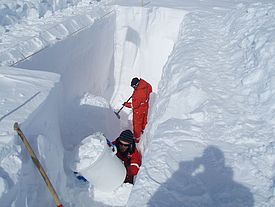The polar snow and ice caps give us a peek through the keyhole into the Earth's past. We study the ways in which Arctic and Antarctic snow "ages" in order to gain a better understanding of these records. We also use climatic models to improve our understanding.
Because of the perpetual sub-zero temperatures, it takes approximately one thousand years in the Antarctic and approximately 100 years on the Greenland ice sheet for the snow to completely turn into ice. As such, the snow and firn pack in the polar regions reaches thicknesses of up to one hundred metres. By way of comparison, snow in the Alps usually transforms into glacier ice within a year, and the snowpack is often only a few meters thick. Another difference between the snowpack in the Alps and the snowpack in the polar regions is that less precipitation falls at high latitudes, and the snow at the poles is worked over much more intensively by strong winds than it is here in Switzerland.
Climate reconstruction
Ice cores are a unique medium for chronicling climatic data. Air bubbles trapped in the ice provide information on the composition of the atmosphere thousands of years ago, which enables climate researchers to reconstruct the climate. The correct interpretation of the cores requires an understanding of exactly how snow becomes firm and then becomes ice, because snow is the starting material of the ice cores.
This is why we regularly collect data such as fresh snowfall quantities, snow profiles, temperatures and erosion measurements, as well as air temperature, humidity, wind and incident radiation. We have also developed our own measuring devices to measure snow properties. In our cold laboratory at the SLF, we use computer tomography to obtain three-dimensional measurements of the snow structure – the process is similar to how a doctor performs a CT scan of a patient's body. These measurements are accurate to one micron. We feed this data into our "SNOWPACK" snowpack and radiation balance model. Although we developed this model for the Alps, we are continually adapting it to process the data collected under polar conditions as well.
Influential reflectors: snow and ice
Polar snowpack plays a decisive role in the global climate system, because the white surfaces of the snow-covered areas in the polar regions reflect up to ninety percent of sunlight. This differs from seawater, which reflects slightly less than thirty percent of the incident sunlight back into space. We study the ways in which the various properties of the snow influence this back-radiation. We also look at the depth to which sunlight penetrates the snow. We feed these results into the "SNOWPACK" model, which helps improve our climate simulations.

